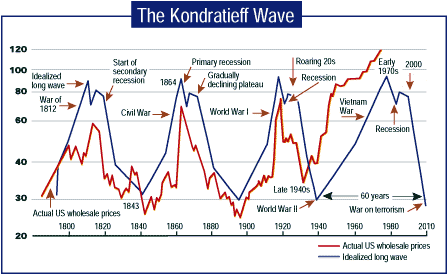The Kondratieff Wave: Tracking the Past or Predicting the Future?

In 1926, Nikolai Kondratieff (also spelled Kondratiev or Kondratyev) published a study called Long Waves in Economic Life for the Agricultural Academy and Business Research Institute in Russia.
Kondratieff noted that capitalist economies have long waves of boom and bust, that he described similar to the seasons in a year. However, for presenting his work to Stalin showing that capitalism will always return, he was imprisoned and then eventually executed.
The four seasons in The Kondratieff Wave are:
- Spring (25 years) – Inflationary phase with rising stock prices and increased employment and wages.
- Summer (3-5 years) – Stagflation phase with rising interest rates, rising debt and stock corrections. Imbalances lead to war.
- Autumn (7-10 years) – Deflation phase where falling interest rates lead to a plateau and stock prices increase sharply.
- Winter (3 year collapse and 15 year readjustment) – Depression phase with stock and debt markets collapsing and commodity prices increasing.

Source: www.chartingstocks.net
So what does all this mean? I found this chart very interesting, especially in today’s economy. I’d like to thank a reader, Dave in Calgary, for emailing this to me. Of course, it’s debateable whether winter is behind us and we’re back into spring… or are we currently in autumn, with winter still to come?


Comments
The simple reality is that the Kondratieff wave can’t be overridden – and the tail end of the Kondratieff wave involves deflation and depression. In fact, the very transition through the later phases of the Kondratieff wave involves high consumer price inflation going to low consumer price inflation eventually going to zero consumer price inflation (which we have had a whiff of already, despite the Fed’s best efforts) followed by negative consumer price inflation, i.e., deflation.
You could definitely see your expertise in the work you write. The arena hopes for more passionate writers like you who are not afraid to say how they believe. All the time follow your heart.
Interesting article. I first came across this reading Michael A Alexander’s publications. If you’re convinced by the analysis, we are in a secular bear market that began around 2000, and should end anywhere from 2018 to 2030. There are some indications the K wave is lengthening. We’re probably in the winter phase, based on your description above.